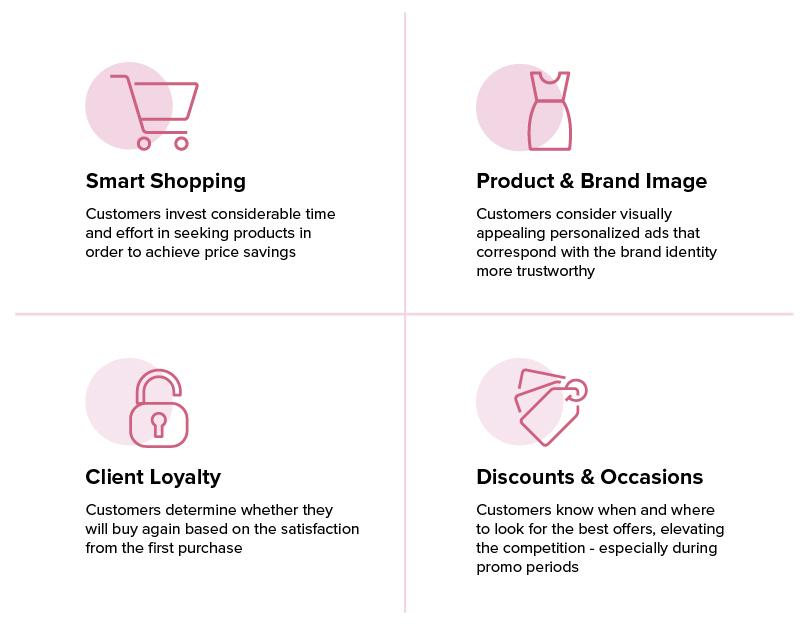Last Updated on: 11th October 2023, 11:59 am
The COVID-19 pandemic has caused a real revolution in the fashion industry. It significantly changed the shopping habits of customers and, consequently, forced the industry to redefine the existing distribution and marketing strategies in order to effectively fight for lost customers and acquire new ones. What fashion trends should be kept in mind while creating a plan for brand presence on the Internet? How does one fight for customer loyalty and build brand image?
In this article you will learn:
- How has the pandemic impacted the fashion industry
- What are the current fashion trends and new challenges
- What is smart shopping
- How to build product & brand image
- How to improve customer loyalty
- What is the most efficient way to acquire customers
Table of Contents:
- The pandemic state of the fashion industry
- Key trends in the fashion industry
- Smart Shopping – customers are becoming more accustomed to efficient buying
- Product & Brand Image – customers are more likely to choose a beautiful design
- Customer Loyalty – satisfied fashion customers are likely to make more than one purchase
- Discounts & Occasions – customers use available information to search for the best occasions
The pandemic state of the fashion industry
There’s no denying that the COVID-19 pandemic has changed the fashion industry on many levels and has forced the industry to redefine its current business strategies.
Restrictions introduced by the governments of many countries very quickly led to a significant drop in revenues, and the need to comply with new sanitary requirements additionally increased the cost of doing business. In addition, frequent supply problems, which have already forced many companies to raise prices (67% of fashion industry executives expect retail prices to rise in 2022), numerous employees on sick leave, and changing consumer shopping habits have not helped sales targets.
Many consumers, fearing the deterioration of their financial situation, have significantly reduced their spending. Many have also turned to online shopping, the effects of which can already be seen on the streets and in shopping malls. UBS Bank forecasts that by 2026 as many as 81,000 stationary stores will have closed in the United States alone, which in the case of the fashion industry means the liquidation of 18% of stationary points of sale.
See also: An All-American Story: In Praise of Malls and Online Marketplaces
However, this does not mean that the fashion industry has not yet recovered from the Covid shock. The recovery of the industry is already noticeable especially in China, but also to some extent in the US. The Chinese fashion market is already back to the pre-Covid sales levels. While the non-luxury segment growth is rather symbolic (2% vs 2019 sales) the for luxury segment was set to reach even 90% over 2019 sales by the end of 2021. The recovery tendency and numbers look totally different in the US – up to 10% and 5% respectively.
In Europe, sales will not reach pre-pandemic levels until 2022. Estimates for 2021 indicate a gap in the sales of non-luxury fashion reaching up to 15% vs. 2019. Luxury brands are expected to be in an even worse position. Luxury segment sales will not even reach 2019 levels in 2022 – mostly due to the fact Chinese tourist spending is expected to be redirected to Mainland China.
According to the authors of “Ecommerce Report 2021”, the annual revenue growth rate for the fashion industry in the years 2021-2025 will be 11.17%. Such a quick recovery of sales was possible largely due to e-commerce, for which the pandemic has been a real catalyst for growth. Therefore, it should come as no surprise that many brands are redefining their distribution strategies, developing their own online channels and improving the existing ones.
Key trends in the fashion industry
Developing a winning distribution strategy is no easy task, but when it comes down to it, don’t forget to take care of the customer experience.
Internet sales channels in many countries already account for over 40% of sales, so it’s worth taking care to build a strong position on the Internet today. Base your business decisions on the data you have, and put modern technology to work. What should be kept in mind when redefining the current distribution strategy?
Smart Shopping – customers are becoming more accustomed to efficient buying
Personalization is key to the success of any distribution strategy, especially through the use of deep learning. It is possible to deliver unique, tailor-made user experiences, support users in making better decisions and save them lots of time. In the case of online sales, its importance is particularly significant, as clearly confirmed by numerous reports and studies. According to Bain & Company specialists, 64% of consumers would be more likely to shop in stores offering recommendations for specific products to purchase. The use of modern recommendation engines in online stores is no longer a good practice, but a necessity.
There is no denying that personalized recommendations made by artificial intelligence are, and will continue to be, the future of e-commerce. Modern recommendation engines, thanks to the use of deep learning, can analyze customer behavior in real time, predict their needs, and on this basis, as well as on the basis of choices made in the past, suggest products which they might like.
The benefits of implementing such a strategy can be extremely rewarding for managers. The results of the 2020 survey on the frequency of using personalized recommendations shows that more than 65 percent of Internet users in the US and UK shop using product recommendations at least occasionally.
Product & Brand Image – customers are more likely to choose a beautiful design
Another challenge for the representatives of the fashion industry is to build brand image – i.e. to define the mission, vision and values that stand behind the brand and with which its customers can identify. As shown by a survey conducted by Harvard Business Review, the young generation (especially Millennials and Generation Z) make their purchasing decisions not only based on the product itself, but also on the story that the brand tells them. As many as 64% of those surveyed indicated that shared values are the reason that builds a bond with a brand.
Of course, that doesn’t mean you can do away with product image altogether. Customers are more likely to consider visually appealing products which they can easily associate with the brand. This is particularly important today, when competition in the online world is fierce, and customers’ attention is competed for not only by independent stores but also by numerous auction sites and sales platforms. Professional product presentation and extensive possibilities of interaction with it (possibility to zoom, rotate, etc.) not only attract the attention of potential customers, but also build greater trust in the brand and can translate positively into conversion.
Companies should ensure a pleasant presentation of products and communicate a consistent brand image through marketing efforts. We’re not just talking about creating eye-catching presentations, but also matching them to the context of the page on which they will appear and adjusting a number of parameters to the individual needs of the brand (e.g. number of advertisements displayed or banner layout). Thanks to modern technology, the possibilities in the field of personalization of advertising creations have entered a whole new level – today it is possible not only to present products tailored to the needs and expectations of specific customers, but also in places where the brand would like to be present. It also opens up completely new possibilities in the context of targeting and retargeting and in consequence increases the chance of turning “window shoppers” into real customers.
Customer Loyalty – satisfied fashion customers are likely to make more than one purchase
Companies should make the effort to convert one-time buyers into loyal consumers in order to maximize LTV through building a brand-customer relationship. In an environment of high uncertainty, many consumers have decided to abandon their old habits and check out new brands or retailers. This trend, according to McKinsey analysts, was particularly evident in the United States, where as many as 46% of consumers decided to take this step.
This poses a big challenge for brands, which needs to be properly addressed when designing a marketing strategy. Building customer loyalty can be done in many different ways, but the most effective is to deliver a personalized experience that exceeds customer expectations.
After one satisfying purchase, customers are more likely to develop trust and loyalty which results in more purchases from the same retailer. By simplifying the shopping process as much as possible and using an intelligent recommendation engine you can effectively build loyalty and significantly increase the value of the shopping cart at the same time. RTB House experience shows that a technologically advanced recommendation system can translate into a 12.5% increase in AOV.
Discounts & Occasions – customers use available information to search for the best occasions
Building a relationship with customers is important, but focusing only on this aspect can be disastrous. You have to remember that customers also expect discounts and promotional campaigns, so they cannot be omitted in any strategy. The reason most people stay in touch with brands is to get tangible benefits in the form of discounts. The key to success is to understand your customers’ needs and offer them the value they expect.
Consumers are consciously waiting for promotional offers for the items they are interested in, so brands should ensure they have the tools and technology to proactively respond to these needs. Companies should use promo periods to manage stock issues and maximize revenue by showing promotional offers to the already-interested consumers who are most likely to make a purchase. Such activities not only facilitate inventory management, but also have a positive impact on the ROI and building loyalty among customers.

The pandemic undoubtedly had a significant impact on the fashion industry and accelerated many changes and trends taking place on the market. Many brands have understood that ignoring and neglecting e-commerce is a fatal act in most cases. The key to success is not only launching an online sales channel, but most of all focusing on unique customer experiences, proper product presentation, building customer loyalty and designing an effective promotional strategy.
If you have any questions, comments or issues, or you’re interested in meeting with us, please get in touch.





